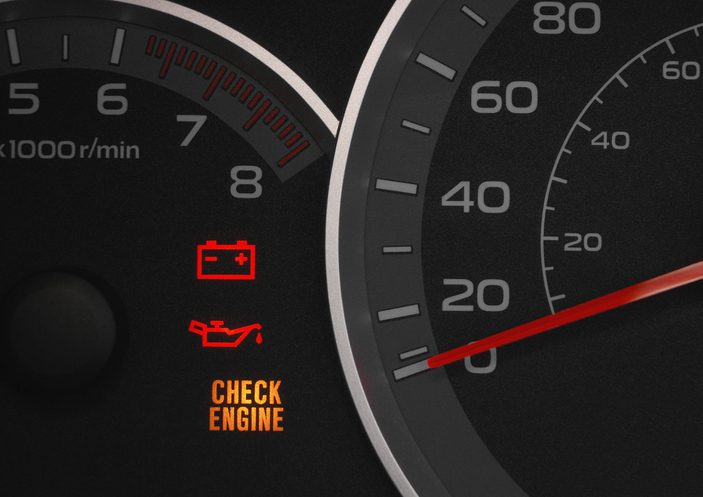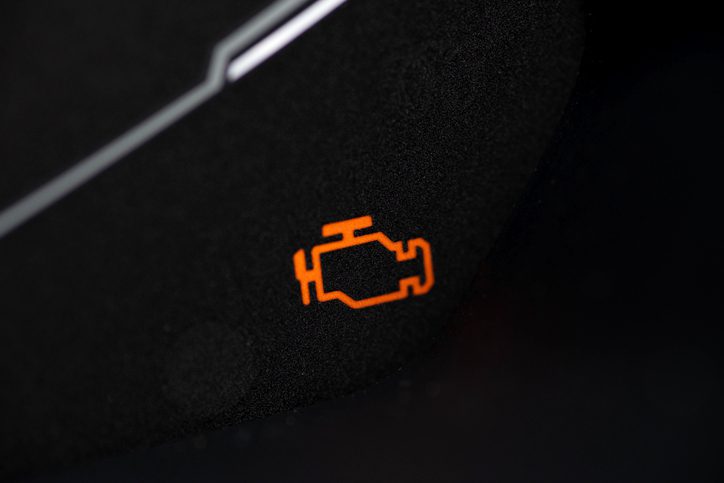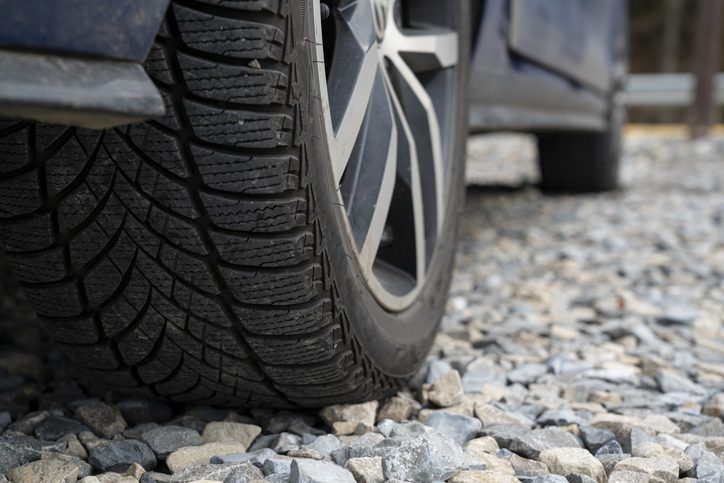Key Takeaways:
- The check engine light can come on for many reasons, from easy fixes like a loose gas cap to more serious engine or emissions problems.
- Ignoring your check engine light risks further damage, higher repair costs and increases the chance of an unexpected breakdown.
- Regular maintenance reduces the chances of false alarms and keeps your car performing at its best. When in doubt, visit a mechanic to identify the root cause.
Almost every driver will find themselves asking, “Why is my check engine light on?” at some point or another. When that happens, a quick look at your owner’s manual can help you understand the different warning symbols, and a speedy follow-up with your mechanic will help prevent bigger issues down the road. To make it even easier, we’ve created a comprehensive guide to help you get to know the ins and outs of your check engine light. That way, you won’t let a surprise breakdown or warning steer you off course.
11 Common Reasons for the Check Engine Light To Be On and What To Do
There are many reasons for the check engine light to come on. Some issues are easy fixes that you can take care of yourself, whereas others may suggest more serious mechanical or emissions system issues that require professional attention.
Seeing your dashboard light up with warnings can be unsettling, especially if you don’t notice any other signs of trouble. We’ve ordered the list below from the most to least common check engine light reasons, so you can get a better sense of where to start.
1. Loose or Damaged Fuel Cap
A cracked or loose gas cap can trigger the check engine light because it allows fuel vapors to escape, disrupting the pressure balance. Not only does this lead to increased emissions, but it can also reduce fuel efficiency.
What To Do: Sometimes, simply tightening the cap is enough to prevent evaporation. However, in the case of a damaged or persistently faulty gas cap, replacement may be necessary.
2. Faulty Oxygen (O2) Sensor
A faulty oxygen sensor can’t accurately measure oxygen levels in your exhaust, making it harder for the engine to adjust the fuel-air mix. This can lead to poor combustion, increased emissions and reduced fuel economy.
What To Do: Repairing or replacing a malfunctioning oxygen sensor usually requires a mechanic. Full replacement will improve performance and prevent further damage and catalytic converter issues.
3. Catalytic Converter Performance Problems
The catalytic converter turns harmful gasoline vapors into less harmful emissions. Left unchecked, a failing catalytic converter can affect engine performance, causing extensive (and expensive) damage.
What To Do: Have the system inspected right away. If your converter is failing, it could indicate upstream problems (like misfires or bad O2 sensors). It may also need to be replaced, which is expensive and oftentimes a last resort.
Do you own a Kia or Hyundai? If so, you may be among the millions of other drivers whose vehicles are at increased risk for catalytic converter theft. Learn how to safeguard your car.
4. Mass Airflow Sensor (MAF) Malfunctions
The mass air flow sensor measures the air entering the engine so the computer knows how much fuel to inject. A dirty or faulty MAF sensor can cause stalling, rough idling and reduced fuel efficiency.
What To Do: Cleaning may help, but in many cases, replacement is required. Driving with a failing sensor leads to reduced engine performance due to too much fuel being burned.
5. Worn or Failing Spark Plugs/Ignition Components
Faulty spark plugs, worn spark plug wires or failing ignition coils can all be reasons that your “check engine” is on. These issues cause cylinders to misfire, which disrupts combustion and puts extra strain on your engine.
What To Do: Replacing spark plugs and related parts is a relatively easy and inexpensive fix, and speedy resolution helps avoid a more serious problem down the road.

6. Engine Misfires
An engine misfire happens when fuel in one or more cylinders fails to ignite at the right time. This can be linked to ignition issues, clogged injectors or compression problems—all of which require immediate attention.
What To Do: Because misfires can stem from several potential issues, your mechanic will likely use a diagnostic code reader to assess the root cause before recommending the necessary repairs.
7. Vacuum System Leaks
Your car’s vacuum system helps regulate air pressure. If a hose cracks or loosens, unmetered air enters the engine, throwing off the air-fuel balance and triggering the light.
What To Do: Minor leaks may only cause rough idling, while bigger ones can lead to stalling. Either way, it’s best to schedule service as soon as possible to prevent further damage.
8. Exhaust Gas Recirculation (EGR) Valve Issues
The EGR valve lowers pollution by routing some exhaust back into the intake so it recirculates gasoline vapors instead of releasing them outright. The check engine light usually comes on if the valve becomes clogged or stuck.
What To Do: Cleaning the valve can sometimes help, but if it’s fully blocked or broken, replacement is the best way to fix the problem and restore performance.
9. Aftermarket Electronics or Alarm Systems
Non-factory electronics like custom alarms, remote starters or stereo systems can sometimes interfere with your vehicle’s sensors and wiring or confuse the computer.
What To Do: If the light came on soon after an aftermarket installation, have the system checked by a professional to confirm the exact problem and make the necessary adjustments.
10. Contaminated or Poor-Quality Fuel
Bad gasoline or contamination in the gas tank can make your engine run unevenly, triggering a warning, though it’s less common. In such cases, it’s normal to notice rough idling or hesitation when accelerating.
What To Do: If the issue stems from fuel quality, running the tank low and refilling with clean gas may be enough to ensure your car runs fine again. Otherwise, a mechanic will have to flush the system.
11. Reduced Engine Power
Have you ever noticed your engine power drop, even when everything else seems to be running fine? The reason could be as simple as an air filter that needs replacing. But the light may also indicate low oil pressure, leaks in hoses or multiple other issues.
What To do: Take your vehicle to a mechanic for a proper diagnostic test. The diagnostic trouble codes will reveal the check engine light reasons.

What Happens if You Ignore the Check Engine Light?
It might be tempting to brush off that glowing dashboard light and keep driving, but the truth is, car issues rarely fix themselves. If you’ve noticed your check engine light come on more often lately, that’s your car’s way of telling you it needs attention. Ignoring the warning can have serious repercussions, including:
- Higher repair costs: Minor glitches can quickly escalate into major (and pricey) repairs.
- Reduced fuel efficiency: Unchecked problems can waste fuel, reducing your mileage per gallon.
- Increased emissions: Failing components often release excess carbon dioxide, which is bad news for both your car and the environment.
- Loss of reliability: Without addressing the root cause, you never know when your engine might give out.
- Breakdowns and safety risks: Cars have a knack for quitting at the worst moment, leaving you stuck on the roadside waiting for a tow truck.
Remember, the check engine light isn’t there to annoy you. It’s there to protect you. Treat it as an early warning system, not an afterthought, and you’ll save yourself stress, money, and time in the long run.
How To Prevent the Check Engine Light From Unnecessary Activation
While you can’t always avoid problems, a few proactive habits can cut down on frustrating false alarms and help keep your vehicle in top shape:
- Tighten the gas cap properly: A loose seal is one of the most common reasons the light turns on. Make sure the cap clicks into place to maintain pressure and prevent evaporation of fuel vapors.
- Stay on top of regular maintenance: Routine oil changes, filter replacements and tune-ups go a long way toward stopping small issues from spiraling into larger ones.
- Use quality fuel: Filling up with good gas reduces the risk of deposits and clogs that can trip a sensor.
- Invest in an inexpensive code reader: This essential glove box item lets you run diagnostic checks yourself to find out whether the underlying issue is a quick fix or something that needs professional attention.
- Fix issues promptly: The sooner you address warning signs, the less likely you are to face unexpected breakdowns or high repair bills.
The primary takeaway is that prevention is always cheaper than repair. With a little care, you can minimize unnecessary warning lights and keep your car running smoothly.
Maintaining Your Vehicle
It’s important to know that car insurance doesn’t usually cover repairs caused by a check engine light, like everyday wear and tear (unless the underlying issue comes from a covered event, such as collision, fire, theft or hitting an animal). However, a well-maintained car paired with the right policy lowers the likelihood of accidents, helps protect you from breakdowns and may potentially even lower insurance claims and premiums.
FAQ: Why Does the Check Engine Light Come On?
What Is the Most Common Reason for a Check Engine Light?
The most common cause is a loose or faulty gas cap. It’s usually a quick fix, but if the light stays on, you should have it checked by a professional to rule out a more serious problem.
Why Is the Engine Light on When My Car Is Running Fine?
Sometimes the light can come on even if the car feels normal. In such cases, sensors may have detected issues that aren’t yet obvious, so you’ll need to schedule a diagnostic test.
What Is the First Thing To Check When the Check Engine Light Comes On?
Start with the gas cap. Make sure it’s tightened properly, since this simple step often solves the problem without a trip to the mechanic.
What’s the Difference Between a Flashing Vs. Solid Check Engine Light?
A solid light usually indicates a less urgent problem, whereas a flashing light signals that something requires immediate attention.
What Can a Solid Check Engine Light Mean?
Often, solid check engine lights are related to an emissions issue or sensor malfunction. Neither is an urgent problem, although it’s still best to get it checked properly to prevent escalation.
Is a Yellow Check Engine Light Serious?
A yellow light is generally a caution sign. It doesn’t necessarily mean your car is unsafe to drive, but it does mean it’s time to schedule diagnostics.
What Does a Solid Orange Engine Light Mean?
An orange light typically means there’s a problem with the engine or emissions system. It’s usually okay to drive, but you should have a mechanic inspect your vehicle as soon as possible.
Is It OK To Drive With a Check Engine Light On?
That depends on whether the light is steady or flashing. A steady light usually means you can keep driving cautiously to a service center, while a flashing light indicates a serious issue that requires more immediate action.
How Long Can You Drive With a Check Engine Light On?
While it’s often feasible to drive with a solid check engine light for some distance, it’s not recommended. The faster you get your vehicle inspected, the easier it is to avoid bigger issues.
How Do I Fix a Check Engine Light?
Presuming the issue has already been remedied, try turning the ignition on and off several times in a row to see if the light resets.
How Much Does It Cost To Fix a Check Engine Light?
Costs vary widely. For example, you could pick up a new gas cap for under $50. However, costs for major components may run into thousands of dollars.
Can I Reset the Check Engine Light Myself?
Yes, you can reset it with a code reader or by disconnecting the battery. Just be aware that this may also reset other settings in your car, and that resetting without fixing the issue means the light will likely return.
Can a Check Engine Light Be False?
Yes. Although uncommon, electrical glitches or errors in the car’s computer system can trigger the light.






